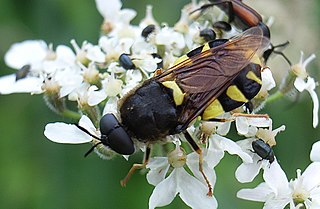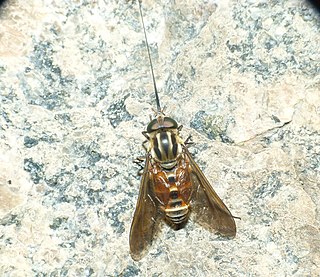
Lipoptena is a genus of flies in the family Hippoboscidae, known as louse flies or keds

Xylota is a Holarctic genus of hoverflies similar in structure to the related genera Chalcosyrphus and Brachypalpoides. As the larvae are saprophytic they're usually found in rotting wood. The adult flies are generally associated with woodland and woodland edges and can often be seen running over the upper sides of leaves. Unlike other syrphids the adults of many species rarely visit flowers preferring instead to gather pollen from leaf surfaces. There are over 100 described species of which 12 can be found in Europe. Seven species have been recorded in Britain. Identification of species has been difficult and identifiction by photographs is risky.
Hippoboscinae is a subfamily of the fly family Hippoboscidae. All are parasitic, and unlike some other members of the Hippoboscidae, all Hippoboscinae are winged species.

Hippobosca is a genus of flies in the family Hippoboscidae. There are seven known species. There are numerous synonyms.

Rutilia is a large genus of medium to large (>20mm) flies in the family Tachinidae native to Australia and the Oriental region, though notably absent from New Zealand. Like the vast majority of tachinid flies, Rutilia species are parasitoids of other insects, specifically Rutilia are known to be parasitoids of late instar larvae of scarab beetles.

Gastrolepta is a genus of flies in the family Tachinidae.

The Milesiini is a large and diverse tribe of hoverflies. They mimic wasps or hornets.

Hippobosca longipennis, the dog fly, louse fly, or blind fly, is a blood-feeding parasite mostly infesting carnivores. The species name "longipennis" means "long wings". Its bites can be painful and result in skin irritation, it is an intermediate host for the canine and hyaenid filarial parasite Dipetalonema dracunculoides, "and it may also be a biological or mechanical vector for other pathogens".

Stratiomys is a genus of flies in the family Stratiomyidae.

Stratiomyini is a tribe of flies in the family Stratiomyidae.

Stratiomyinae is a subfamily of flies in the family Stratiomyidae.

Beridinae is a subfamily of soldier flies in the family Stratiomyidae.

Elassogaster is a genus of scavenger flies (Diptera) belonging to the family Platystomatidae. They are native to warm regions of Africa, Madagascar, Asia and Australia.

Cyphomyia is a genus of flies in the subfamily Clitellariinae.

Philoliche is a genus of long-tongued Horse-flies found in the Old World. It appears to be the sole member of tribe Philolichini.

Pangoniinae is a subfamily of horse-flies in the order Diptera, containing at seven tribes and over 40 genera.
Limata is a genus of biting horseflies of the family Tabanidae.
Donovanius is a subgenus of flies in the family Tachinidae.
Hippobosca variegata is a species of fly in the family Hippoboscidae.
Lipoptena capreoli is a species of fly in the family Hippoboscidae. It is found in India, Pakistan, southern Europe, and western Asia.













